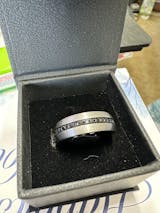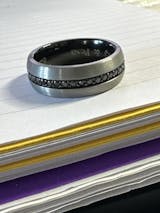Getting The Right Fit
The ideal wedding ring fit should be snug, but not too tight, providing enough resistance when trying to take it off.
A properly fitting ring should slide over your knuckle with a little friction and fit snugly on your finger. To remove the ring, you should feel some resistance and need to apply a little extra force to slide it back over your knuckle. This ensures that your ring won't accidentally slip off while going about your daily activities.
Keep in mind that finger sizes can change depending on various factors like temperature, time of day, and even weight fluctuations. It's a good idea to get your finger sized more than once by different jewelers. When getting sized, consider doing it in the mid to late afternoon, as this is when your fingers tend to be at their largest stable size of the day.
Here are some tips to help you find the perfect wedding ring fit:
-
Consider the ring width: Wider rings might feel tighter, so if you're choosing a wedding band with a wider design, consider opting for a slightly larger size.
-
Account for knuckle size: Some people have small knuckles, which makes it difficult for a tighter ring to slide over them. Make sure your ring can easily be put on and taken off, while still feeling secure on your finger.
-
Visit multiple jewelers: As mentioned earlier, be sure to get sized by different jewelers for an accurate measurement. You can also ask them for advice on choosing the right ring fit.
-
Individual finger types: Note that everyone's fingers and knuckles are different, so it's essential to find a ring that fits your unique anatomy comfortably.
-
Give it time: After wearing your ring for a while, you might notice it feels looser or tighter than initially anticipated. Give your body time to adjust and be open to resizing your ring if necessary.
Factors Affecting How a Ring Fits
There are several factors that can impact how a wedding ring fits on your finger. It's essential to consider these factors when choosing the perfect ring to ensure maximal comfort and security.
Finger size and knuckle: Your finger size can change over time, and your knuckles often play a considerable role in determining the fit of your ring. If you have small knuckles, it might be more challenging to find a snug fit that doesn't slip off your finger. Conversely, larger knuckles may create resistance when putting on or removing the ring.
Temperature: Changes in temperature can affect your finger size, causing them to expand or contract. Cold conditions generally cause fingers to shrink, while hot conditions can lead to swelling. When choosing a wedding ring, it's crucial to select a fit that accommodates these fluctuations.
Swelling: Apart from temperature, other factors can cause swelling in your fingers. Pregnancy, exercise, and changes in blood circulation can all contribute to temporary changes in finger size. Make sure your ring fit accounts for these potential changes.
Resistance and circulation: Physical activities, such as exercise, can increase blood flow and pressure in your fingers, causing rings to tighten. It's essential to choose a ring that can accommodate these pressure changes without causing discomfort or loss of circulation.
Salt intake and bloating: Eating salty foods or experiencing bloating due to hormonal changes can temporarily alter the size of your fingers. Keep this in mind when selecting a ring fit that remains comfortable, even during periods of bloating.
Arthritis: People with arthritis may experience changes in their finger size and shape, making it difficult to find a comfortable and secure ring fit. Consider adjustable or easily resizable rings to accommodate changes caused by arthritis. Don't hesitate to consult a professional for guidance on finding the perfect ring for your specific needs.
Consequences of Poor Ring Fit
A poorly fitting wedding ring can lead to several problems, including pain, discomfort, and even the risk of losing your ring. Here's some of the main issues that can arise from a ring that doesn't fit properly.
If your ring is too tight, you may experience pain and discomfort in your finger. This tightness can cause your finger to become swollen, making the ring even more difficult to remove. Additionally, a ring that's too tight can restrict blood flow, leading to a tingling sensation or even a change in your finger's color to blue or purple. This is a serious sign that your ring needs to be resized immediately to avoid further complications.
On the other hand, when your ring is too loose, it may constantly spin around your finger, causing annoyance and making it difficult to wear comfortably. The loose fit also increases the likelihood of your ring slipping off without you noticing, potentially resulting in the loss of your precious wedding band.
Frequently Asked Questions
Do you need to size up the wedding band?
No, you don't necessarily need to size up the wedding band. When choosing a wedding ring, it should fit snugly on your finger without feeling too tight or loose. It should slide over your knuckle with a little resistance. Reach out to the company you're buying from for an accurate size chart.
Is a spinning ring too loose?
A spinning ring might be slightly loose, but it's not always a problem. Some rings, especially those with a top-heavy design, can cause spinning due to the weight distribution. However, if your ring spins too easily or feels like it might slip off, you may want to consider getting it resized for a more secure fit.
Should it be difficult to remove a ring?
Removing a ring should require some effort, but it shouldn't be too difficult. A proper-fitting ring should easily slide over your knuckle with a bit of resistance. If you're struggling to remove a ring, it may be too tight and could cause discomfort or circulation issues.
Does a tight ring in the morning indicate improper fit?
A tight ring in the morning could be a result of various factors, including changes in temperature, humidity, and salt intake, which can cause temporary swelling of your fingers. If your ring consistently feels too tight throughout the day, it may be a sign of an improper fit.
Is it normal for a ring to leave an indent?
Yes, it's normal for a ring to leave a slight indent on your finger, especially after wearing it for extended periods. This is due to the pressure exerted by the ring on your skin. However, if the indent is deep or causes discomfort, it may indicate the ring is too tight.
What is the correct ring positioning?
The correct ring positioning depends on personal preference and cultural customs. Typically, a wedding band is worn on the left hand's ring finger (next to the pinky) since it's believed that a vein in that finger, the "vena amoris," connects directly to the heart. For engagement rings, they are usually placed on the same finger, either above or below the wedding band, depending on your preference.




